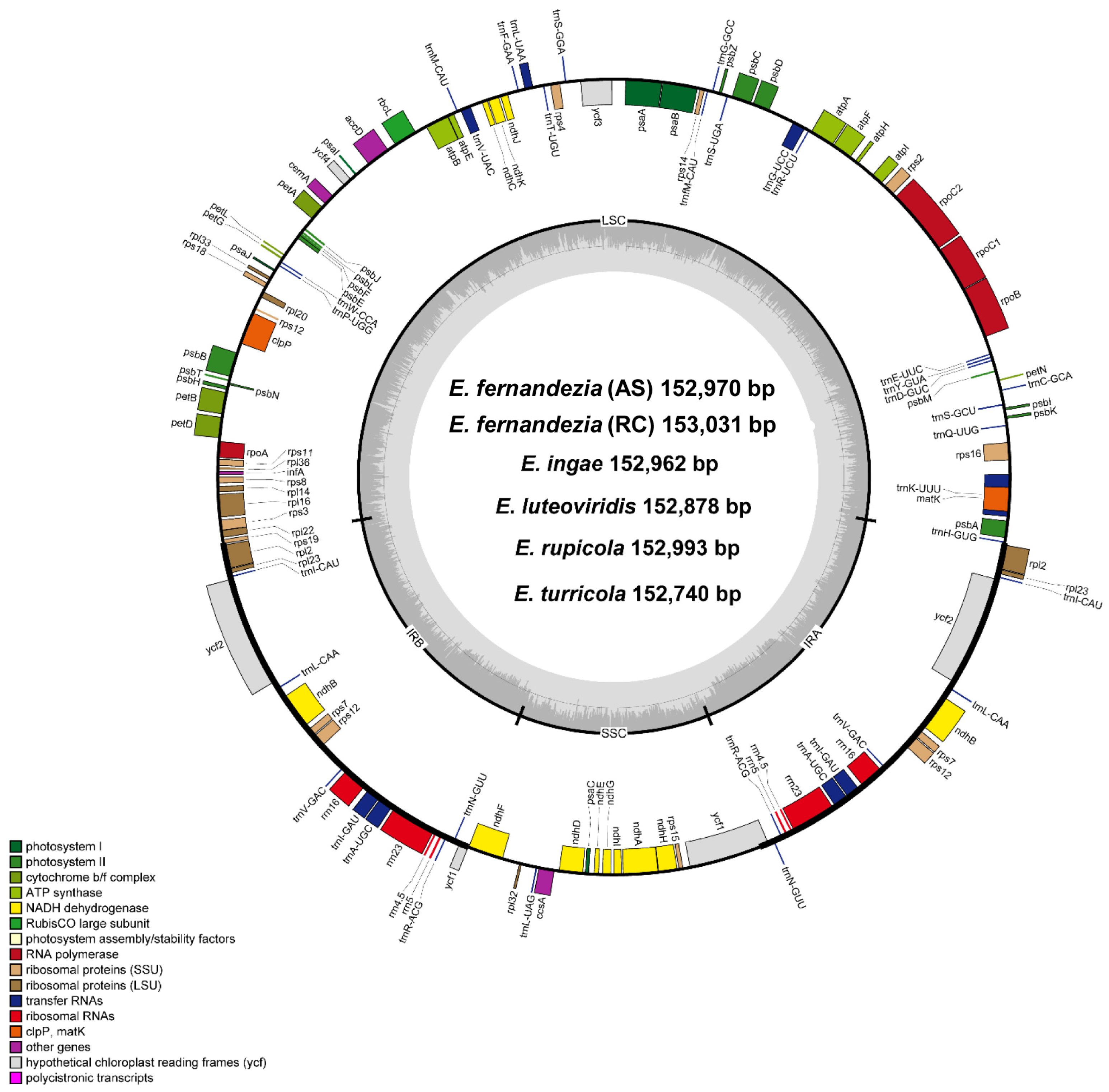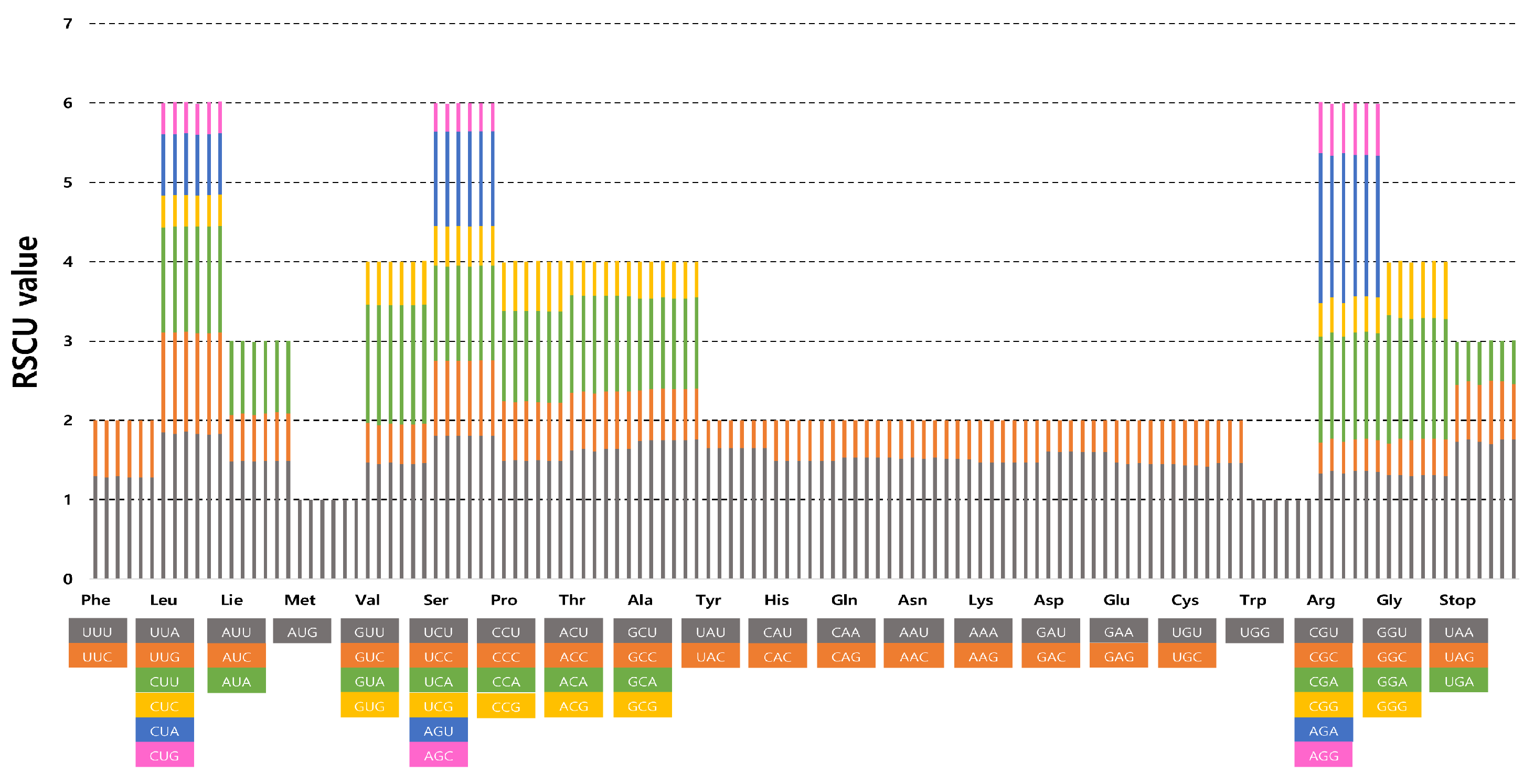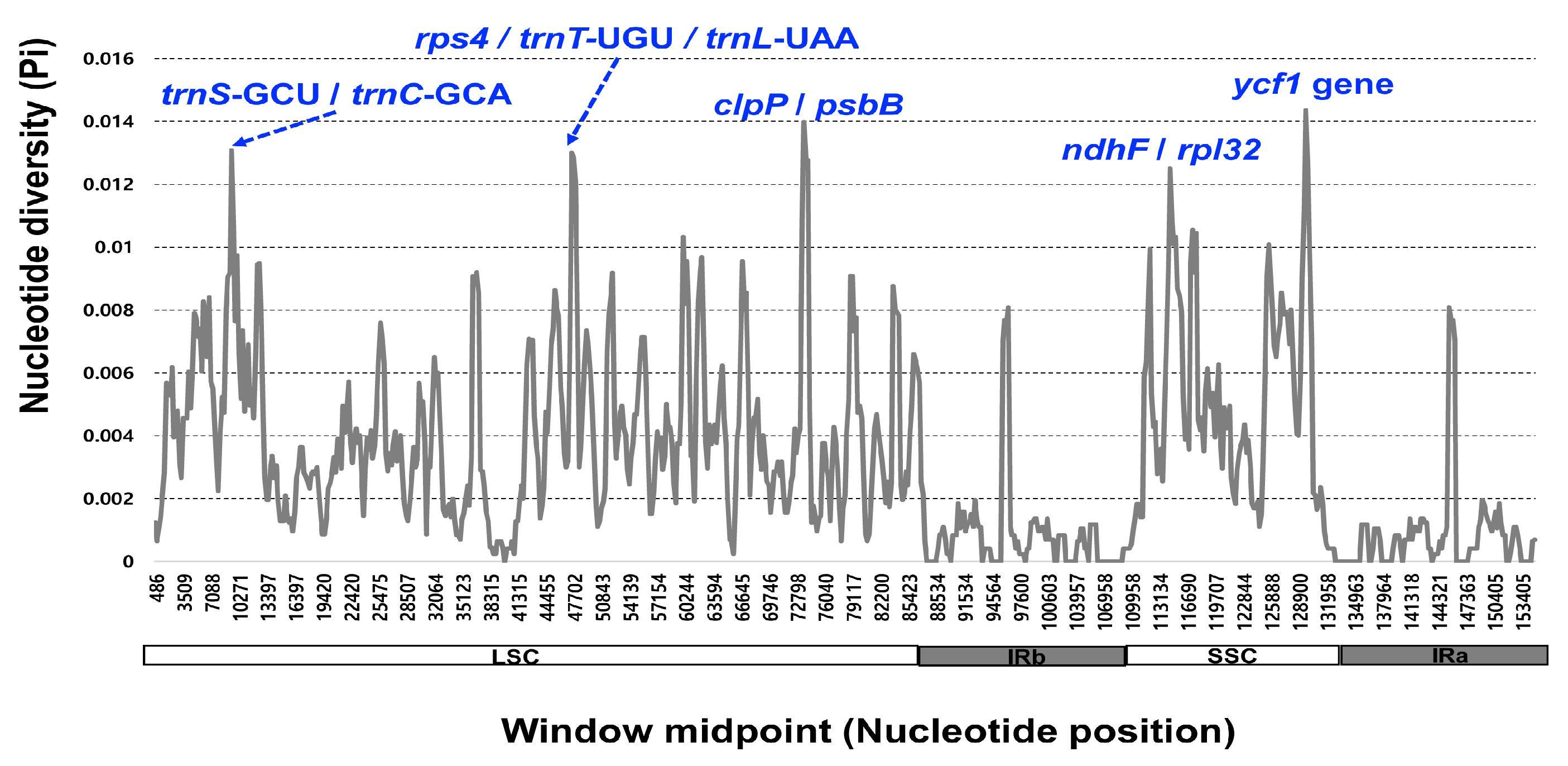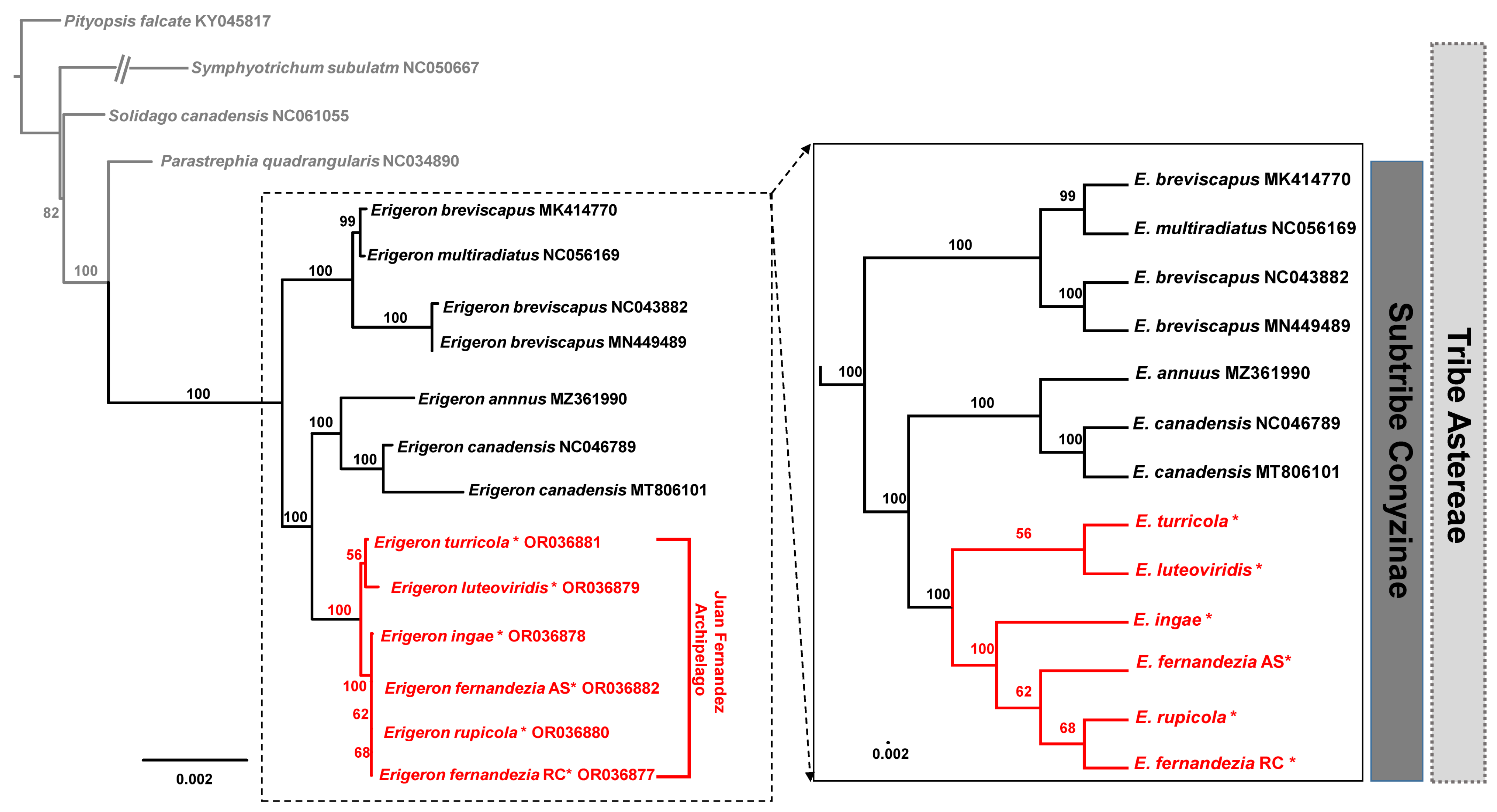Chloroplast Genome Provides Insights into Molecular Evolution and Species Relationship of Fleabanes (Erigeron: Tribe Astereae, Asteraceae) in the Juan Fernández Islands, Chile
Abstract
1. Introduction
2. Results
2.1. Genome Size and Features
2.2. Comparative Analysis of Genome Structure
2.3. Phylogenetic Analysis
3. Discussion
3.1. Chloroplast Genome Structure and Evolution in Genus Erigeron
3.2. Adaptive Radiation of Erigeron on the Younger Island of the Juan Fernández Archipelago
4. Materials and Methods
4.1. Plant Sampling, DNA Isolation, and Plastome Sequencing, Assembly and Annotation
4.2. Comparative Plastome Analysis
4.3. Phylogenetic Analysis
Supplementary Materials
Author Contributions
Funding
Data Availability Statement
Conflicts of Interest
References
- Stuessy, T.F.; Foland, K.A.; Sutter, J.F.; Sanders, R.W.; Silva, M. Botanical and geological significance of potassium-argon dates from the Juan Fernandez Islands. Science 1984, 225, 49–51. [Google Scholar] [CrossRef]
- Stuessy, T.F.; Crawford, D.J.; Marticorena, C. Patterns of phylogeny in the endemic vascular flora of the Juan Fernandez Islands, Chile. Syst. Bot. 1990, 15, 338–346. [Google Scholar] [CrossRef]
- Skottsberg, C. Derivation of the flora and fauna of Juan Fernandez and Easter Island. Nat. Hist. Juan Fernandez Easter Isl. 1956, 1, 193–438. [Google Scholar]
- Stuessy, T.F. Centres of plant diversity: A guide and strategy of their conservation. In Juan Fernández Islands; Davis, S.D., Heywood, V.H., Hamilton, A.C., Eds.; IUCN Publications Unit: Cambridge, UK, 1995; pp. 565–568. [Google Scholar]
- Marticorena, C.; Stuessy, T.F.; Baeza, M. Catálogo de la flora vascular del Archipiélago de Juan Fernández, Chile. Gayana Bot. 1998, 55, 187–211. [Google Scholar]
- Stuessy, T.F.; Ruiz, E.; Crawford, D.J.; Tremetsberger, K. Testing degrees of genetic divergence and populational variation in oceanic island archipelagos: Juan Fernandez as a model system. Nova Acta Leopold. 2005, 92, 147–165. [Google Scholar]
- Takayama, K.; López-Sepúlveda, P.; Greimler, J.; Crawford, D.J.; Peñailillo, P.; Baeza, M.; Ruiz, E.; Kohl, G.; Tremetsberger, K.; Gatica, A.; et al. Genetic consequences of cladogenetic vs. anagenetic speciation in endemic plants of oceanic islands. AoB Plants 2015, 7, plv102. [Google Scholar] [CrossRef] [PubMed]
- Valdebenito, H.; Stuessy, T.F.; Crawford, D.J.; Silva, M. Evolution of Erigeron (Compositae) in the Juan Fernandez Islands, Chile. Syst. Bot. 1992, 17, 470–480. [Google Scholar] [CrossRef]
- Solbrig, O.T. Note on Gymnosperma glutinosum (Compositae-Astereae). Leafl. West. Bot. 1961, 9, 147–150. [Google Scholar]
- Noyes, R.D. Biogeographical and evolutionary insights on Erigeron and allies (Asteraceae) from ITS sequence data. Plant Syst. Evol. 2000, 220, 93–114. [Google Scholar] [CrossRef]
- Solbrig, O.T.; Anderson, L.C.; Kyhos, D.W.; Raven, P.D.; Rüdenberg, L. Chromosome numbers in Compositae. V. Astereae. II. Am. J. Bot. 1964, 51, 513–519. [Google Scholar] [CrossRef]
- Sanders, R.W.; Stuessy, T.F.; Rodriguez, R. Chromosome numbers from the flora of the Juan Fernandez Islands. Am. J. Bot. 1983, 70, 799–810. [Google Scholar] [CrossRef]
- Spooner, D.M.; Stuessy, T.F.; Crawford, D.J.; Silva, M. Chromosome numbers from the flora of the Juan Fernandez Islands. II. Rhodora 1987, 89, 351–356. [Google Scholar]
- Sun, B.-Y.; Stuessy, T.F.; Crawford, D.J. Chromosome counts from the flora of the Juan Fernandez Islands, Chile. III. Pac. Sci. 1990, 44, 258–264. [Google Scholar]
- López-Sepúlveda, P.; Takayama, K.; Greimler, J.; Crawford, D.J.; Peñailillo, P.; Baeza, M.; Ruiz, E.; Kohl, G.; Tremetsberger, K.; Gatica, A.; et al. Speciation and Biogeography of Erigeron (Asteraceae) in the Juan Fernández Archipelago, Chile, based on AFLPs and SSRs. Syst. Bot. 2015, 40, 888–899. [Google Scholar] [CrossRef]
- Reichelt, N.; Wen, J.; Patzold, C.; Appelhans, M.S. Characterization of the four Zanthoxylum L. species (Sapindales: Rutaceae) from the Caribbean, Madagascar, the Mascarene Islands, and the South Pacific. Microbial Resour. Announc. 2021, 10, e00399-21. [Google Scholar]
- Yang, J.Y.; Chiang, Y.-C.; Hsu, T.-W.; Kim, S.-H.; Pak, J.-H.; Kim, S.-C. Characterization and comparative analysis among plastome sequences of eight endemic Rubus (Rosaceae) species in Taiwan. Sci. Rep. 2021, 11, 1152. [Google Scholar] [CrossRef]
- Yang, J.Y.; Takayama, K.; Youn, J.-S.; Pak, J.-H.; Kim, S.-C. Plastome characterization and phylogenomics of east Asian beeches with a special emphasis on Fagus multinervis on Ulleung Island, Korea. Genes 2020, 11, 1338. [Google Scholar] [CrossRef]
- Cho, M.-S.; Kim, S.-H.; Yang, J.Y.; Crawford, D.J.; Stuessy, T.F.; López-Sepúlveda, P.; Kim, S.-C. Plastid phylogenomics of Dendroseris (Cichorieae; Asteraceae): Insights into structural organization and molecular evolution of an endemic lineage from the Juan Fernández Island. Front. Plant Sci. 2020, 11, 594272. [Google Scholar] [CrossRef]
- Go, A.-R.; Yoo, K.-O. Comparative genomics of Viola selkirkii and V. ulleungdoensis (Violaceae). Korean J. Plant Taxon. 2023, 53, 38–46. [Google Scholar] [CrossRef]
- Cho, M.-S.; Yang, J.Y.; Yang, T.-J.; Kim, S.-C. Evolutionary comparison of the chloroplast genome in the woody Sonchus alliance (Asteraceae) on the Canary Islands. Genes 2019, 10, 217. [Google Scholar] [CrossRef]
- Serna-Sánchez, M.; Pérez-Escobar, O.A.; Bogarín, D.; Torres-Jimenez, M.F.; Alvarez-Yela, A.C.; Arcila-Galvis, J.E.; Hall, C.F.; de Barros, F.; Pinheiro, F.; Dodsworth, S.; et al. Plastid phylogenomics resolves ambiguous relationships within the orchid family and provides a solid timeframe for biogeography and macroevolution. Sci. Rep. 2021, 11, 6858. [Google Scholar] [CrossRef] [PubMed]
- Li, Z.-Z.; Gichira, A.W.; Muchuku, J.K.; Li, W.; Wangm, G.-X.; Chen, J.-M. Plastid phylogenomics and biogeography of the genus Monochoria (Potederiaceae). J. Sys. Evol. 2021, 59, 1027–1039. [Google Scholar] [CrossRef]
- Ross, T.G.; Barrett, C.F.; Gomez, M.S.; Lam, V.K.Y.; Henriquez, C.L.; Les, D.H.; Davis, J.I.; Cuenca, A.; Petersen, G.; Seberg, O.; et al. Plastid phylogenomics and molecular evolution of Alismatales. Cladistics 2016, 32, 160–178. [Google Scholar] [CrossRef] [PubMed]
- Song, Y.; Yu, W.-B.; Tan, Y.-H.; Jin, J.-J.; Wang, B.; Yang, J.-B.; Liu, B.; Corlett, R.T. Plastid phylogenomics improve phylogenetic resolution in the Lauraceae. J. Syst. Evol. 2020, 58, 423–439. [Google Scholar] [CrossRef]
- Li, Z.-J.; Liu, Y.-Y.; Yang, C.-W.; Qian, Z.-G.; Li, G.-D. The complete chloroplast genome sequences of Erigeron breviscapus and Erigeron multiradiatus (Asteraceae). Mitochondrial DNA B Resour. 2019, 4, 3826–3827. [Google Scholar] [CrossRef] [PubMed]
- Wang, A.; Wu, H.; Zhu, X.; Lin, J. Species identification of Conyza bonariensis assisted by chloroplast genome sequencing. Front. Genet. 2018, 9, 374. [Google Scholar] [CrossRef] [PubMed]
- Wicke, S.; Schneeweiss, G.M.; dePamphilis, C.W.; Muller, K.F.; Quandt, D. The evolution of the plastid chromosome in land plants: Gene content, gene order, gene function. Plant Mol. Biol. 2011, 76, 273–297. [Google Scholar] [CrossRef]
- Oh, S.-H.; Park, J. The complete chloroplast genome of Erigeron canadensis isolated in Korea (Asteraceae): Insight into the genetic diversity of the invasive species. Korean J. Plant Taxon. 2023, 53, 47–53. [Google Scholar] [CrossRef]
- Lihová, J.; Kudoh, H.; Marhold, K. Genetic structure and phylogegraphy of a temperate-boreal herb, Cardamine scutata (Brassicaceae), in northeast Asia inferred from AFLPs and cpDNA haplotypes. Am. J. Bot. 2010, 97, 1058–1070. [Google Scholar] [CrossRef]
- Bi, Y.; Zhang, M.F.; Xue, J.; Dong, R.; Du, Y.P.; Zhang, X.H. Chloroplast genomic resources for phylogeny and DNA barcoding: A case study on Fritillaria. Sci. Rep. 2018, 8, 1184. [Google Scholar] [CrossRef]
- Dastpak, A.; Osaloo, S.K.; Maassoumi, A.A.; Safar, K.N. Molecular phylogeny of Astragalus sect. Ammodendron (Fabaceae) inferred from chloroplast ycf1 gene. Ann Bot. Fenn. 2018, 55, 75–82. [Google Scholar] [CrossRef]
- Gutierréz-Rodríguez, C.; Ornelas, F.J.; Rodríguez-Gómez, F. Chloroplast DNA phylogeography of a distylous shrub (Palicourea padifolia, Rubiaceae) reveals past fragmentation and demographic expansion in Mexican cloud forests. Mol. Phylogenetics Evol. 2011, 61, 603–615. [Google Scholar] [CrossRef]
- Zhang, G.; Wang, Z.; Wu, H.; Sun, M. Chloroplast phylogeography of Iris dichotoma (Iridaceae), a widespread herbaceous species in East Asia. Nord. J. Bot. 2020, 38, e02888. [Google Scholar] [CrossRef]
- Dong, S.; Ying, Z.; Yu, S.; Wang, Q.; Liao, G.; Ge, Y.; Cheng, R. Complete chloroplast genome of Stephania tetrandra (Menispermaceae) from Zhejiang Province: Insights into molecular structures, comparative genomic analysis, mutational hotspots, and phylogenetic relationships. BMC Genom. 2021, 22, 880. [Google Scholar] [CrossRef]
- Wang, C.; Yap, Z.-Y.; Wan, P.; Chen, K.; Folk, R.A.; Damrel, D.Z.; Barger, W.; Diamond, A.; Horn, C.; Landry, G.P.; et al. Molecular phylogeography and historical demography of a widespread herbaceous species from eastern North America, Podophyllum peltatum. Am. J. Bot. 2023, 110, 216254. [Google Scholar] [CrossRef]
- Xie, Z.; Merchant, S. The plastid-encoded ccsA gene is required for heme attachment to chloroplast c-type cytochromes. J. Biol. Chem. 1996, 271, 4632–4639. [Google Scholar] [CrossRef]
- Dong, W.-L.; Wang, R.-N.; Zhang, N.-Y.; Fan, W.-B.; Fang, M.-F.; Li, Z.-H. Molecular evolution of chloroplast genomes of orchid species: Insights into phylogenetic relationship and adaptive evolution. Int. J. Mol. Sci. 2018, 19, 716. [Google Scholar] [CrossRef]
- Yang, J.Y.; Kim, S.-H.; Pak, J.-H.; Kim, S.-C. Infrageneric plastid genomes of Cotoneaster (Rosaceae): Implications for the plastome evolution and origin of C. wilsonii on Ulleung Island. Genes 2022, 13, 728. [Google Scholar] [CrossRef]
- Zhang, Z.-R.; Yang, X.; Li, W.-Y.; Peng, Y.-Q.; Gao, J. Comparative chloroplast genome analysis of Ficus (Moraceae): Insight into adaptive evolution and mutational hotspot regions. Front. Plant Sci. 2022, 13, 965335. [Google Scholar] [CrossRef]
- Hu, S.; Sablok, G.; Wang, B.; Qu, D.; Barbaro, E.; Viola, R.; Li, M.; Varotto, S. Plastome organization and evolution of chloroplast genes in Cardamine species adapted to contrasting habitats. BMC Genom. 2015, 16, 306. [Google Scholar] [CrossRef]
- Gao, L.-Z.; Liu, Y.-L.; Zhang, D.; Li, W.; Gao, J.; Liu, Y. Evolution of Oryza chloroplast genome promoted adaptation to diverse ecological habitats. Commun. Biol. 2019, 2, 278. [Google Scholar] [CrossRef]
- Liu, Q.; Li, X.; Li, M.; Xu, W.; Heslop-Harrison, J.S. Comparative chloroplast genome analyses of Avena: Insights into evolutionary dynamics and phylogeny. BMC Plant Biol. 2020, 20, 406. [Google Scholar] [CrossRef]
- Li, J.L.; Tang, J.M.; Zeng, S.Y.; Han, F.; Yuan, J.; Yu, J. Comparative plastid genomics of four Pilea (Urticaceae) species: Insights into interspecific plastid genome diversity in Pilea. BMC Plant Biol. 2021, 21, 25. [Google Scholar] [CrossRef]
- Wen, F.; Wu, X.; Li, T.; Jia, M.; Liu, X.; Liao, L. The complete chloroplast genome of Stauntonia chinensis and compared analysis revealed adaptive evolution of subfamily Lardizabaloideae species in China. BMC Genom. 2021, 22, 161. [Google Scholar] [CrossRef]
- Yang, J.Y.; Kang, G.-H.; Pak, J.-H.; Kim, S.-C. Characterization and comparison of two complete plastomes of Rosaceae species (Potentilla dickinsii var. glabrata and Spiraea insularis) endemic to Ulleung Island, Korea. Int. J. Mol. Sci. 2020, 21, 4933. [Google Scholar] [CrossRef]
- Wang, Y.; Wen, F.; Hong, X.; Li, Z.; Mi, Y.; Zhao, B. Comparative chloroplast genome analyses of Paraboea (Gesneriaceae): Insights into adaptive evolution and phylogenetic analysis. Front. Plant Sci. 2022, 13, 1019831. [Google Scholar] [CrossRef]
- Carbonell-Caballero, J.; Alonso, R.; Ibañez, V.; Terol, J.; Dopazo, J. A phylogenetic analysis of 34 chloroplast genomes elucidates the relationships between wild and domesticated species within the genus Citrus. Mol. Biol. Evol. 2015, 32, 2015–2035. [Google Scholar] [CrossRef]
- Caspermeyer, J. Most comprehensive study to date reveals evolutionary history of Citrus. Mol. Biol. Evol. 2015, 32, 2217–2218. [Google Scholar] [CrossRef]
- Maddison, W.P.; Knowles, L.L. Inferring phylogeny despite incomplete lineage sorting. Syst. Biol. 2006, 55, 21–30. [Google Scholar] [CrossRef]
- Yu, Y.; Than, C.; Degnan, J.H.; Nakhleh, L. Coalescent histories on phylogenetic networks and detection of hybridization despite incomplete lineage sorting. Syst. Biol. 2011, 60, 138–149. [Google Scholar] [CrossRef]
- Stuessy, T.F.; Crawford, D.J.; Greimler, J. Human impacts on the vegetation of the Juan Fernández (Robinson Crusoe) Archipelago. Plants 2023, 12, 4038. [Google Scholar] [CrossRef]
- Solbrig, O.T. The South American species of Erigeron. Contr. Gray Herb. 1962, 191, 3–79. [Google Scholar] [CrossRef]
- Zhuang, Y.; Wang, X.; Li, X.; Hu, J.; Fan, L.; Landis, J.B.; Cannon, S.B.; Grimwood, J.; Schmutz, J.; Jackson, S.A.; et al. Phylogenomics of the genus Glycine sheds light on polyploid evolution and life-strategy transition. Nat. Plants 2022, 8, 233–244. [Google Scholar] [CrossRef]
- Wagner, N.D.; He, L.; Hörandl, E. Phylogenomic relationships and evolution of polyploid Salix species revealed by RAD sequencing data. Front. Plant Sci. 2020, 11, 1077. [Google Scholar] [CrossRef]
- Rothfels, C.J. Polyploid phylogenetics. New Phytol. 2021, 230, 66–72. [Google Scholar] [CrossRef]
- Zerbino, D.R.; Birney, E. Velvet: Algorithms for de novo short read assembly using de Bruijn graphs. Genome Res. 2008, 18, 821–829. [Google Scholar] [CrossRef]
- Lowe, T.M.; Eddy, S.R. tRNAscan-SE: A program for improved detection of transfer RNA genes in genomic sequence. Nucleic Acids Res. 1997, 25, 955–964. [Google Scholar] [CrossRef]
- Kearse, M.; Moir, R.; Wilson, A.; Stones-Havas, S.; Cheung, M.; Sturrock, S. Geneious Basic: An integrated and extendable desktop software platform for the organization and analysis of sequence data. Bioinformatics 2012, 28, 1647–1649. [Google Scholar] [CrossRef]
- Greiner, S.; Lehwark, P.; Bock, R. Organellar genome DRAW (OGDRAW) version 1.3.1: Expanded toolkit for the graphical visualization of organellar genomes. Nucleic Acids Res. 2019, 47, W59–W64. [Google Scholar] [CrossRef]
- Brundo, M.; Malde, S.; Poliakov, A.; Do, C.B.; Couronne, O.; Dubchak, I. Global alignment: Finding rearrangements during alignment. Bioinformatics 2003, 19 (Suppl. S1), i54–i62. [Google Scholar] [CrossRef]
- Frazer, K.A.; Pachter, L.; Poliakov, A.; Rubin, E.M.; Dubchak, I. VISTA: Computational tools for comparative genomics. Nucleic Acids Res. 2004, 32, W273–W279. [Google Scholar] [CrossRef]
- Katoh, K.; Standley, D.M. MAFFT multiple sequence alignment software v7: Improvements in performance and usability. Mol. Biol. Evol. 2013, 30, 772–780. [Google Scholar] [CrossRef]
- Rozas, J.; Ferrer-Mata, A.; Sánchez-DelBarrio, J.; Guirao-Rico, S.; Librado, P.; Ramos-Onsins, S.E. DnaSP v6: DNA sequence polymorphism analysis of large datasets. Mol. Biol. Evol. 2017, 34, 3299–3302. [Google Scholar] [CrossRef]
- Kumar, S.; Stecher, G.; Tamura, K. MEGA7: Molecular evolutionary genetics analysis version 7.0 for bigger datasets. Mol. Biol. Evol. 2016, 33, 1870–1874. [Google Scholar] [CrossRef]
- Sharp, P.M.; Li, W.H. The codon adaptation index-A measure of directional synonymous codon usage bias, and its potential applications. Nucleic Acids Res. 1987, 15, 1281–1295. [Google Scholar] [CrossRef] [PubMed]
- Kozak, M. Comparison of initiation of protein synthesis in procaryotes, eucaryotes, and organelles. Microbiol. Rev. 1983, 47, 1–45. [Google Scholar] [CrossRef] [PubMed]
- Gao, F.; Chen, C.; Arab, D.A.; Du, Z.; He, Y.; Ho, S.Y.W. EasyCodeML: A visual tool for analysis of selection using CodeML. Ecol. Evol. 2019, 9, 3891–3898. [Google Scholar] [CrossRef]
- Yang, Z. PAML: A program package for phylogenetic analysis by maximum likelihood. Bioinformatics 1997, 13, 555–556. [Google Scholar] [CrossRef]
- Nguyen, L.-T.; Schmidt, H.A.; von Haeseler, A.; Minh, B.Q. IQ-TREE: A fast and effective stochastic algorithm for estimating maximum-likelihood phylogenies. Mol. Biol. Evol. 2015, 32, 268–274. [Google Scholar] [CrossRef]





| Taxa | E. fernandezia (AS) | E. fernandezia (RC) | E. ingae | E. luteoviridis | E. rupicola | E. turricola |
|---|---|---|---|---|---|---|
| Total cpDNA size (bp) | 152,970 | 153,031 | 152,962 | 152,878 | 152,993 | 152,740 |
| GC content (%) | 37.2% | 37.2% | 37.2% | 37.2% | 37.2% | 37.2% |
| LSC size (bp)/GC content (%) | 84,611/35.1% | 84,630/35.1% | 84,597/35.1% | 84,605/35.1% | 84,635/35.1% | 84,864/35.1% |
| IR size (bp)/GC content (%) | 25,012/43.0% | 25,023/43.0% | 25,012/43.0% | 25,027/43.0% | 25,012/43.0% | 24,770/43.0% |
| SSC size (bp)/GC content (%) | 18,335/31.0% | 18,355/31.0% | 18,341/31.0% | 18,219/30.9% | 18,334/31.0% | 18,336/30.9% |
| Number of genes | 130 | 130 | 130 | 130 | 131 * | 130 |
| Number of protein-coding genes | 85 | 85 | 85 | 85 | 85 | 85 |
| Number of tRNA genes | 36 | 36 | 36 | 36 | 36 | 36 |
| Number of rRNA genes | 8 | 8 | 8 | 8 | 8 | 8 |
| Number of duplicated genes | 17 | 17 | 17 | 17 | 17 | 17 |
| Accession Number | OR036882 | OR036877 | OR036878 | OR036879 | OR036880 | OR036881 |
| Gene Name | Models | np | ln L | Likelihood Ratio Test p-Value | Positively Selected Sites |
|---|---|---|---|---|---|
| ccsA | M8 | 14 | −1274.227378 | 0.000000000 | 94 Q 0.967 * |
| M7 | 12 | −1295.780345 | |||
| ndhF | M8 | 14 | −2751.256419 | 0.000000315 | 702 P 0.996 ** |
| M7 | 12 | −2766.227043 |
Disclaimer/Publisher’s Note: The statements, opinions and data contained in all publications are solely those of the individual author(s) and contributor(s) and not of MDPI and/or the editor(s). MDPI and/or the editor(s) disclaim responsibility for any injury to people or property resulting from any ideas, methods, instructions or products referred to in the content. |
© 2024 by the authors. Licensee MDPI, Basel, Switzerland. This article is an open access article distributed under the terms and conditions of the Creative Commons Attribution (CC BY) license (https://creativecommons.org/licenses/by/4.0/).
Share and Cite
Kim, S.-H.; Yang, J.; Cho, M.-S.; Stuessy, T.F.; Crawford, D.J.; Kim, S.-C. Chloroplast Genome Provides Insights into Molecular Evolution and Species Relationship of Fleabanes (Erigeron: Tribe Astereae, Asteraceae) in the Juan Fernández Islands, Chile. Plants 2024, 13, 612. https://doi.org/10.3390/plants13050612
Kim S-H, Yang J, Cho M-S, Stuessy TF, Crawford DJ, Kim S-C. Chloroplast Genome Provides Insights into Molecular Evolution and Species Relationship of Fleabanes (Erigeron: Tribe Astereae, Asteraceae) in the Juan Fernández Islands, Chile. Plants. 2024; 13(5):612. https://doi.org/10.3390/plants13050612
Chicago/Turabian StyleKim, Seon-Hee, JiYoung Yang, Myong-Suk Cho, Tod F. Stuessy, Daniel J. Crawford, and Seung-Chul Kim. 2024. "Chloroplast Genome Provides Insights into Molecular Evolution and Species Relationship of Fleabanes (Erigeron: Tribe Astereae, Asteraceae) in the Juan Fernández Islands, Chile" Plants 13, no. 5: 612. https://doi.org/10.3390/plants13050612
APA StyleKim, S.-H., Yang, J., Cho, M.-S., Stuessy, T. F., Crawford, D. J., & Kim, S.-C. (2024). Chloroplast Genome Provides Insights into Molecular Evolution and Species Relationship of Fleabanes (Erigeron: Tribe Astereae, Asteraceae) in the Juan Fernández Islands, Chile. Plants, 13(5), 612. https://doi.org/10.3390/plants13050612








